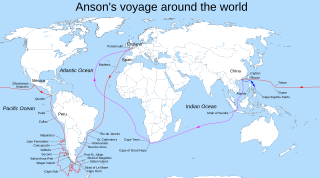 W
WThis is a list of circumnavigations of Earth. Sections are ordered by ascending date of completion.
 W
WThe 1966 Soviet submarine global circumnavigation, was announced to be the second submerged around-the-world voyage executed by the detachment of the nuclear powered submarines that served in the Soviet Navy.
 W
WThe first Indian circumnavigation in a sail boat was undertaken in 1985-1987 by a team comprising officers of the Indian Army Corps of Engineers on yacht Trishna, a 1970-vintage Swan 37 sloop.
 W
WThe first Russian circumnavigation of the Earth took place from August 1803 to August 1806 and was carried out on ships Nadezhda and Neva under the command of Adam Johann von Krusenstern and Yuri Lisyansky. The expedition was initially planned as a commercial enterprise of the Russian-American Company to supply Kamchatka Peninsula and other Russian settlements in Alyaska, as well as to consolidate Russia's position in the remote possessions in the Pacific Ocean.
 W
WThe first voyage of James Cook was a combined Royal Navy and Royal Society expedition to the south Pacific Ocean aboard HMS Endeavour, from 1768 to 1771. It was the first of three Pacific voyages of which James Cook was the commander. The aims of this first expedition were to observe the 1769 transit of Venus across the Sun, and to seek evidence of the postulated Terra Australis Incognita or "undiscovered southern land".
 W
WFrancis Drake's circumnavigation, also known as Drake's Raiding Expedition, was an important historical maritime event that took place between 15 December 1577 and 26 September 1580. Authorised by Queen Elizabeth I and led by Francis Drake; the latter sailed with five ships in what was termed a 'voyage of discovery', although in effect it was an ambitious covert raiding voyage and the start of England's challenge to Spain's global domination.
 W
WWhile Great Britain was fighting the War of Jenkins' Ear with Spain in 1740, Commodore George Anson led a squadron of eight ships on a mission to disrupt or capture the Pacific Ocean possessions of the Spanish Empire. Returning to Britain in 1744 by way of China and thus completing a circumnavigation of the globe, the voyage was notable for the capture of the Manila Galleon but also for horrific losses from disease with only 188 men of the original 1,854 surviving. An account of the voyage was published in 1748 which being widely read by the general public was a great commercial success and "is still esteemed as the story of a remarkable voyage extremely well told".
 W
WThe Great White Fleet was the popular nickname for the group of United States Navy battleships which completed a journey around the globe from 16 December 1907 to 22 February 1909 by order of United States President Theodore Roosevelt. Its mission was to make friendly courtesy visits to numerous countries while displaying new U.S. naval power to the world.
 W
WIt’s on the Meter – World Taxi Challenge was a round-the-world motoring expedition that broke the Guinness World Records for the longest ever journey by taxi and the highest altitude ever reached by taxi. The expedition’s three-man team used a 1992 Fairway Driver London Black Cab to drive 43,319.5 miles (69,716.12 km) around the world.
 W
WIn 1519, Portuguese explorer Ferdinand Magellan led a Spanish expedition with a fleet known as the Armada de Molucca to reach the Moluccas or Spice Islands. After the death of Magellan in the Philippines in 1521 and following several other short-leaderships, the Spanish navigator Juan Sebastián Elcano led the expedition to the Spice Islands and ultimately the return trip to Spain, resulting in the first circumnavigation of the world in 1522. Thus the expedition is called the Magellan–Elcano circumnavigation.
 W
WOperation Power Flite was a United States Air Force mission in which three Boeing B-52 Stratofortresses became the first jet aircraft to circle the world nonstop, when they made the journey in January 1957 in 45 hours and 19 minutes, using in-flight refueling to stay aloft. The mission was intended to demonstrate that the United States had the ability to drop a hydrogen bomb anywhere in the world.
 W
WOperation Sandblast was the code name for the first submerged circumnavigation of the world, executed by the United States Navy nuclear-powered radar picket submarine USS Triton (SSRN-586) in 1960 under the command of Captain Edward L. Beach Jr.. The New York Times described Triton's submerged circumnavigation of the Earth as "a triumph of human prowess and engineering skill, a feat which the United States Navy can rank as one of its bright victories in man's ultimate conquest of the seas."
 W
WOperation Sea Orbit was the 1964 around-the-world cruise of the United States Navy's Task Force One, consisting of USS Enterprise (CVAN-65), USS Long Beach (CGN-9), and USS Bainbridge (DLGN-25). This all-nuclear-powered unit steamed 30,565 miles unrefuelled around the world for sixty-five days.
 W
WMS Tûranor PlanetSolar, known under the project name PlanetSolar, founded by the Swiss explorer Raphaël Domjan, is the largest solar-powered boat in the world and launched on 31 March 2010.
 W
WThe United States Exploring Expedition of 1838–1842 was an exploring and surveying expedition of the Pacific Ocean and surrounding lands conducted by the United States. The original appointed commanding officer was Commodore Thomas ap Catesby Jones. Funding for the original expedition was requested by President John Quincy Adams in 1828, however, Congress would not implement funding until eight years later. In May 1836, the oceanic exploration voyage was finally authorized by Congress and created by President Andrew Jackson.